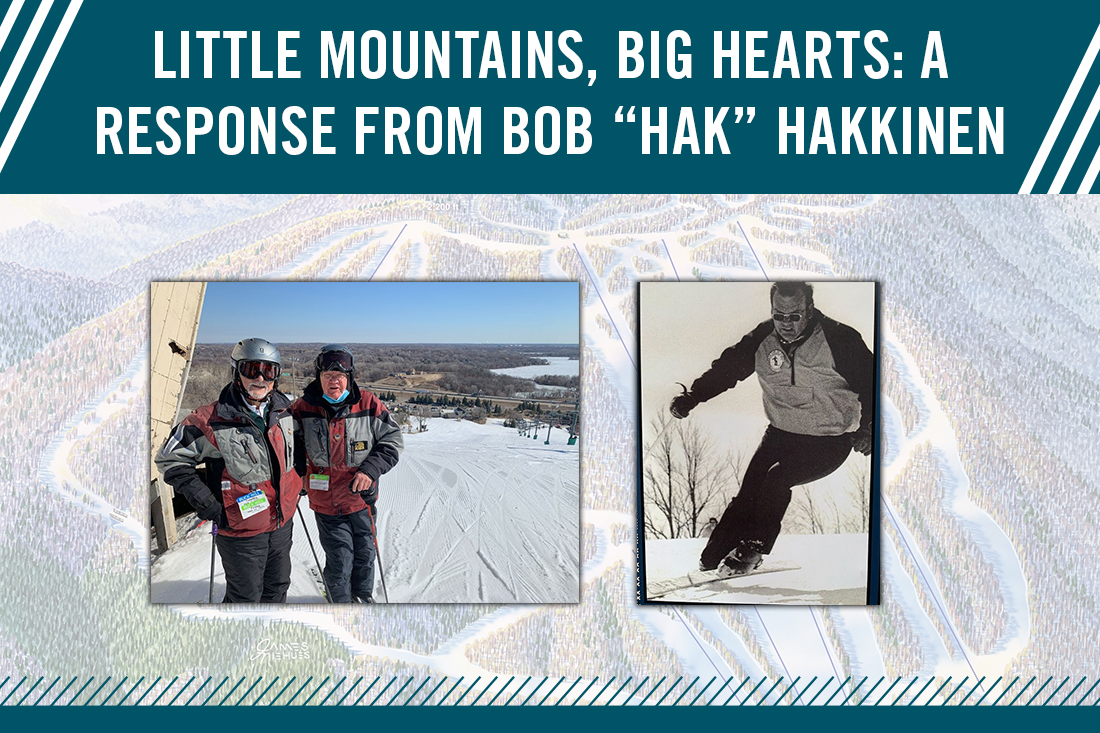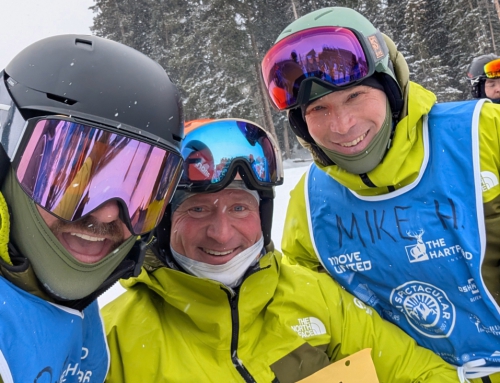Little Mountains, Big Hearts: A Response from Bob “Hak” Hakkinen
Robert “Hak” Hakkinen earned PSIA Central Division certification pin #00159 in 1962, promptly pinned it to his parka, and hasn’t taken a run without it since.
When we first contacted Hak to share his thoughts about the early days of instruction in the Central and Rocky Mountain divisions for “Little Mountains, Big Hearts,” a feature in the winter issue of 32 Degrees, he responded with a beautiful history of his life skiing and teaching in the Upper Peninsula (U.P.) of Michigan.
Here are some highlights in his words:
The U.P.
Kids in the U.P. are destined to play in the snow. With about six months of snow cover, “Yoopers” treat the snow season as an opportunity to play winter games. Like most Yooper kids, I started skiing on the open hillsides of nearby farmers’ fields. The fire of passion for skiing really came to life as I entered high school in Bessemer, Michigan. My classmate, Paul Mascotti, was similarly afflicted. We teamed up to petition the school principal, locate a faculty advisor, and organize an alpine ski team.
To our surprise, the proposal was approved. We recruited additional skiers, gathered maple saplings for gates, and obtained permission to use a steeply sloped part of Mussatti’s Farm as a training site. Foot packing, climbing up after each run, and avoiding that one BIG sapling, that was always the typical practice session.
Local ski areas like Mt. Zion in Ironwood, Michigan, and Mt. Joy in Wakefield, Michigan, offered new terrain, improved snow conditions, and a rope tow for uphill transportation. All this skiing activity was largely driven by individual efforts and community entrepreneurship. The big event in the area for alpine skiing was the development of Indianhead Mountain Ski Area (now known as Jackson Creek), which was scheduled to open in November 1959. At last, we had a major ski area where we could train and take advantage of the longer and steeper slopes.
In addition, we were able to pick up valuable technical expertise from the European skiers hired to operate the ski school. Our quest for experiencing additional ski terrain found us traveling to Mt. Telemark, in Cable, Wisconsin. The ski team loaded into my dad’s ’51 Ford F1 pick-up, three in the cab and four in the topper clad, propane heated, bench equipped truck box for a day of skiing, training, and enjoying the “ski life.” Thus, the foundation for a lifetime of skiing was set.
The PSIA Connection
After high school, we attended Gogebic Community College, a small junior college, in Ironwood. We started the alpine ski team in 1960. College racing was the next chapter. In 1961-62 several of us became certified ski instructors. Paul Mascotti, John Thors, and I continue our PSIA Level III credentials to this day. Our college racing days ended as we were declared professional skiers and were barred from racing by the rules because we were no longer amateur skiers.
As teaching skiing and coaching ski racers replaced our personal racing endeavors, our need to learn about “mountain skiing” brought us to the Colorado Rockies. Our first experience in the mountains took place at Winter Park in 1961.
We had a natural inclination to learn as much about our expanding world of skiing and the ski business. We asked a lot of questions. We had a knack of being able to meet and develop meaningful relationships with the leaders and principals of the areas we visited. Our PSIA connection was the passport to expanding our knowledge and experience.
We were fortunate to be at the beginning of the development of the American Ski Technique as presented by PSIA. We were able to influence the ski teaching methodology and practice. Everything in skiing was expanding, changing, and becoming more universal. There was no status quo. We were functioning like pioneers.
With the development of PSIA, we had a national identity and an international relevance. We found that our Midwestern skiing skills were also mountain skiing skills.
Growing the Sport
Jackson Creek is about one-tenth to one-fifth the size of the Western Mountain resorts. It has the steeps, 200+ inch annual snow conditions, and great grooming, which is common in the mountain resorts.
Our skiing skills and knowledge transferred seamlessly. Our adjustments were in adapting to more grandiose scenery, long uphill rides, and lengthy runs to the bottom of the mountain. The major adjustment was to reduce the number of turns made per run by increasing the turn radius to a more Giant Slalom and cruising mode from the slalom-like Midwestern shorter turns.
The Western ski runs allowed the Midwest skiers to play longer per run and rest longer on the ride up. The cost of the experiences was a bit higher in the 1960s and 1970s. Today, the costs are significantly higher.
As prices moved higher, the trend to ski less often seemed to grow. In the 1970s and 1980s, the ski week package was popular in the Midwest. Guests would visit the ski area for an entire week.
The ski week package was a multi-faceted experience. Food, lodging, daily lessons, après ski parties, and other activities filled the week with fun and excitement. The holiday skiers still come in solid numbers. The weekend warriors have dwindled. The rising costs of transportation, food, and lodging has changed the weekend regular to a once or twice a month enthusiast.
The cost of equipment is another budgetary consideration. As all the costs continue to rise, the avid skier still finds a way to get mileage with a smile … “Smileage”!
The Smile Doctors
Ski instructors are the smile doctors. The parents enroll their children in classes to develop the foundational skills for a lifetime sport. The beginner or novice is searching for confidence, control, and skills to enjoy the mountain. The advanced and expert skier is moving to moguls, powder, and competitive skiing challenges. The intermediate masses are looking to erase the worried frown and wear the smile found in a fun experience. Still, as with ski instructors, staffing shortages are common in all business areas.
Skiing in the Midwest is special. While our ski areas may lack the vertical height, the Midwestern skier exists on a mountain of possibilities. As the skier is concentrating on chasing the perfect turn, the mind is turning on the perfect mountain slope.
Midwestern skiers accumulate their daily vertical in smaller bites with shorter rides in greater numbers. It is harder to go missing at a Midwestern ski area. The skier is closer to the warm fireplace, the snack shack, beverage service, and the circle of friends both known and newly found.
The typical smaller Midwest ski area is more personally connecting. At the typical Midwestern ski area, a skier is more likely to encounter the ski area owner or manager than a guest service associate. The history and culture of the locally developed ski area is tangible and obvious. The small local ski area has character. A locally run ski area feels like a home.
The Western Upper Peninsula is my skiing home. The local ski areas – Mt. Zion, Mt. Joy, Jackson Creek, Big Powderhorn, Black River Basin, and the Whitecap Mountains (in nearby Wisconsin) – have inspired skiers of all ages. Eighty-seven years ago, a Mt. Zion lift ticket (rope tow) was a nickel! Today, a nickel won’t get much anywhere. However, gravity is free, snow blows in from Lake Superior, and perfect turns are attainable wherever snowsports thrive.
Bob Hakkinen
PSIA Alpine Level III (1962)
PSIA-C Examiner (mid- to late 1960s)
Powderhorn Mountain Ski School – 1968-92
High School Alpine Ski Coach – 26 years
President (retired), Minnesota State High School Alpine Ski Coaches Association – 10 years
Minnesota Alpine Ski Coach of the Year – 1997-98
Otto Hollaus Ski School, St. Paul, Minnesota, Director, Ski Masters & Race Program – 25 years
Indianhead Mountain Ski School – 1961-68, 1992-present







